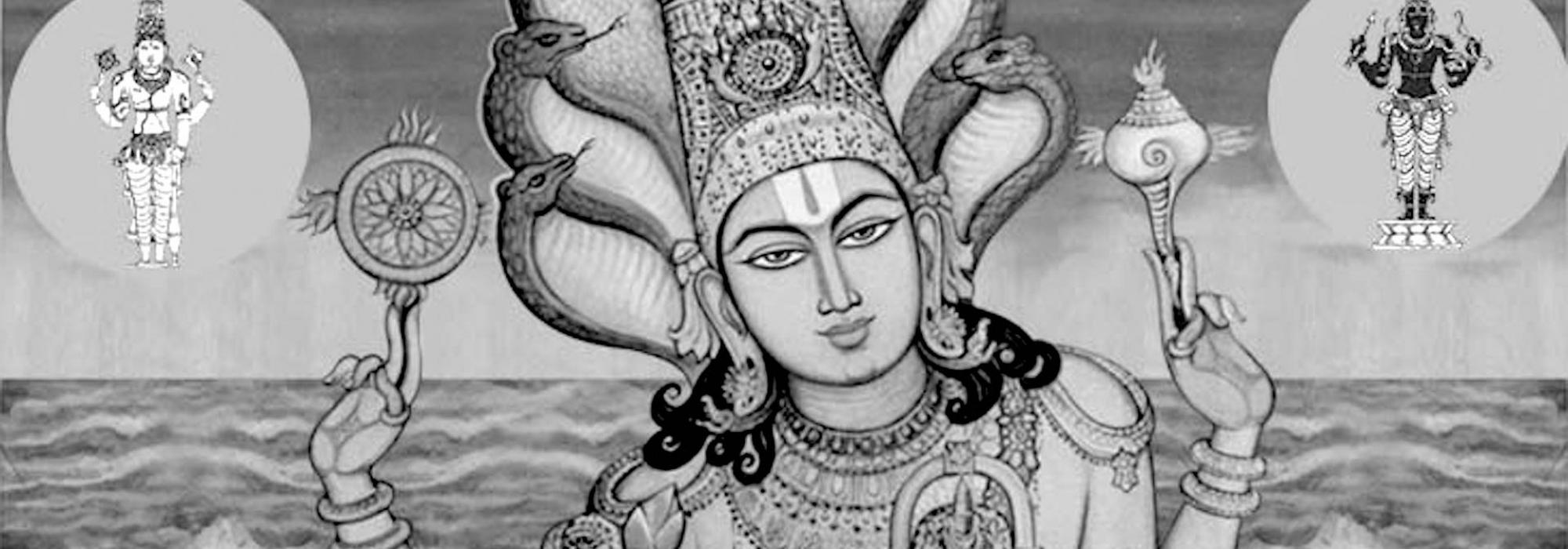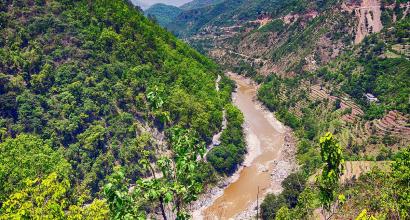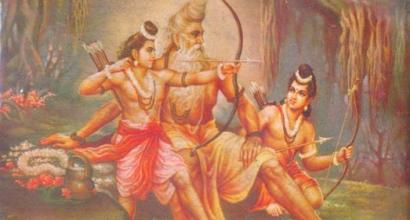The Four Vyuhas of Vishnu
The mention of the Four Vyuhas occurs in the pāñcarātra āgama. The Paramatman has four Avataras namely, vyūha, vibhava, arcāvatāra, antaryāmī. In the vyūha Avatara, there are four types namely, vāsudeva, saṃkarṣaṇa, pradyumna, and Aniruddha. This is the reason for the moniker of Four Vyuhas. Vyuha means Murti. Accordingly, the Trigunas of Sattva, Rajas and Tamas are respectively referred to as vaikārika, taijasa, and bhūtādi. This terminology is used in the Bhagavatam in the same sense.
vaikārikastaijasaśca tāmasaścetyahaṃ trivṛt || (11.24.7)
Likewise, mention is also made of the Four Vyuhas:
namaste vāsudevāya namaḥ saṃkarṣaṇāya ca। pradyumnāyāniruddhāya tubhyaṃ bhagavate namaḥ || (11.5.29)
The terms, sātvata and bhagavata appearing in the pāñcarātra āgama are also liberally used in the Bhagavatam. The Vishnupurana also recognizes the Four Vyuhas:
Om namo vāsudevāya namaḥ saṃkarṣaṇāya ca।
Pradyumnāya namastubhyamaniruddhāya te namaḥ || (5.18.58)
In all these places, the Four Vyuhas indicate the different forms and aspects of the Paramatman. There is no differentiation among all these Murtis.
While the original pāñcarātra āgama comprises 250 Samhitas, only 13 are currently extant. In the Lakshmi Tantra available to us now, saṃkarṣaṇa’s jiva emanates from vāsudeva. From saṃkarṣaṇa’s jiva emanates that of Pradyumna (signifying the Mind). From Pradyumna’s jiva emanates Aniruddha (signifying the Ego). The āhirbudhnya Samhita makes no distinction between the Four Vyuhas. Both the Vishnupurana and the Bhagavatam accept this non-distinction.
In his śārīrakamīmāṃsa, Sri Sankaracharya has criticized the conception of the Four Vyuhas (Brahmasutra 2.2.42 – 45). It must be clearly understood that this criticism is directed at the Four Vyuhas which makes distinctions. It is not directed at the Four Vyuhas as described in the Vishnupurana and the Bhagavatam. The pāñcarātra āgama is available in a scattered fashion and its hypothesis does not have a fundamental unity to it. The jiva is born from the Paramatman; the Mind is born from jiva; Ego is born from the Mind. Thus, Adi Sankara says that these conceptions are not backed by evidence and are full of errors and therefore, are not consonant with the Vedic philosophy. Further, Lakshmi Tantra and similar Samhitas expound the Four Vyuhas which are based upon duality. Besides, although some terms occurring in the pāñcarātra āgama do occur in the Bhagavatam, it does not describe their underlying philosophy nor does it mention anything about the method of Sādhana.
The Bhagavatam clearly embraces the philosophical course elucidated by the Bhagavad Gita. In reality, the secret of the Four Vyuhas has been indicated in the Bhagavatam itself. In the wakeful state, the world itself is known as saṃkarṣaṇa. In the dream state, Pradyumna manifests as light (Tejas). Pure Knowledge in the state of deep sleep (Sushupti), is known as Aniruddha. Vāsudeva is the Witness to all these Three States (Avastha). See: 12.11.21 and 22.
Vishnu is the Most Exalted
The Bhagavatam says that every human must worship Vishnu for his own auspice. It is indisputable that this work propounds the all-encompassing glory of Vishnu. It is for this reason that all Vaishnavas—irrespective of sects—regard the Bhagavatam with utmost reverence and consider it their foundational text. However, the Bhagavatam avers that worshipping the Sattva-Murti Vishnu brings joy and auspice. It does not assign the highest place to him from an attitude of creating divisions among the Trimurtis.
sattvaṁ rajas tama iti prakṛter guṇās tair
yuktaḥ paraḥ puruṣa eka ihāsya dhatte |
sthity-ādaye hari-viriñci-hareti saṁjñāḥ
śreyāṁsi tatra khalu sattva-tanor nṛṇāṁ syuḥ (1.2.23)
The Paramatman is indirectly associated with the three gunas, namely virtue, activity and ignorance, and just for the material world's creation, maintenance and destruction, He accepts the three qualitative forms of Brahmā, Viṣṇu and Śiva. Of these three, all human beings can derive the ultimate benefit from Viṣṇu, the highest form of Sattva.
The One Paramatman assumes different names and forms for the purpose of Creation and other activity. One may refer to the following verses:
1. ādāvabhūt (11.4.5)
2. na te mayyacyuteje ca (12.10.22)
3. “Me (Vishnu), Brahma and Shiva are the fundamental cause for this Creation. I assume the form of Maya which is imbued with Gunas, and I create and protect and dissolve. According to my actions, I assume different names. The ignorant person, from his divisive mindset, sees distinctions in the non-dual Brahman as manifested in the Five Elements and as Brahma and Rudra.” (4.7.50 – 53)
4. namo jagatsthānalayodayeṣu
gṛhītamāyāguṇavigrahāya | (4.30.32)
5. dhatte yadā svadṛg bhūman
brahmāviṣṇu śivābhidhāṃ (8.7.23)
When the Rishi Markandeya, the great devotee of Vishnu, was in a state of Samadhi, Shiva appeared in his heart through Yoga. Then, when Markandeya emerged from his Samadhi, Shiva appeared before him in his physical form as well. At that point, Markandeya eulogises Shiva as follows:
namaḥ śivāya śāntāya satvāya pramruḍāya ca |
rajośuṣepyaghorāya namastubhyaṃ tamojuṣe ||
It is notable that in this sloka Shiva is praised as an exalted or special form of the three gunas. When Shiva speaks to this Rishi, he says, “the three of us, Brahma-Vishnu-Shiva are those who grant Moksha. People endowed with True Knowledge (Jnani) do not see distinctions among me, Achyuta (Vishnu) and Brahma.” After this, Markandeya says, “Swamin, You have created this universe by your mind and then You have yourself entered it. You are the embodiment of the Trigunas as well as their director. You are second to none. You are the Guru and the Parabrahman. I bow down to you.” (12.10)
Shiva was not invited to the Yajna of Daksha, which is why even Brahma and Vishnu did not attend it. Daksha who condemned Shiva and Bhrugu Maharshi, Vishnu’s Bhakta but imprecator of Shiva, were both punished by the pramathagaṇa-s (Chapter 7, Section 4.2).
Those who create artificial divisions between Shiva and Vishnu and condemn them respectively might perhaps learn some lessons from such episodes.
It is true that the Trimurtis are manifested forms. However, the formless Parabrahman is their fundamental and real nature.
The Bhagavatam extolls Vishnu’s manifested form complete with the conch and discus. However, in various instances, it also clearly describes his un-manifested nature. Although both the manifested and un-manifested descriptions occur in a mixed form, we must have the clarity to separate them to gain a fuller understanding. This is because the Bhagavatam clearly elucidates the underlying philosophical tenets of the real nature of the Trimurtis.
guṇamayyā svaśaktyāsya sargasthityapyayān vibho |
dhatte yadā svadṛgbhūman brahmāviṣṇuśivābhidhāṃ || 1 ||
O Almighty, O All-Encompassing, you are the Self-evident Knowledge. When you are involved in performing various acts of natural dissolution, you assume the names of Brahma and Vishnu through your own strength, which is imbued with Gunas.
jyotiḥ paraṃ yatra rajastamaśca |
satvaṃ na, yad brahma nirastabhedaṃ || 2 ||
O Swamin, the real nature of your Divine Light is unknowable even to Brahma, Vishnu and Indra. It is scattered. It does not have the Gunas of Rajas, Tamas and Sattva. (This occurs in the hymn to Shiva. Skanda 8, Chapter 7, Verse 23. The fifteen verses starting with this describe the nature of Parabrahman.)
To be continued
















































